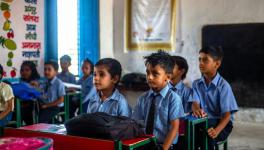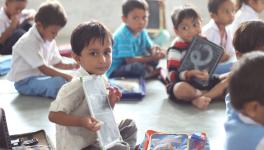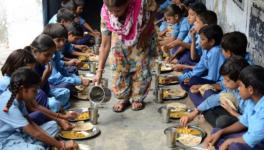Sharp Drop in Children’s Reading Ability Post Covid, Finds ASER 2022 Report
Representational use only.image courtesy: Wikimedia Commons
New Delhi: Charting the state of post-Covid school education in India, across government and private sector, a new report has found that while there was a rise in enrolment, there was a sharp drop in overall learning and reading among school-going children.
As per the Annual State of Education Report (ASER) report, brought out by Pratham Foundation and released on Wednesday, as the pandemic ebbed, school enrolment touched a record high in 2022 — 98.4% of children in the 6-14 age group are now in school, up from 97.2% in 2018 when the organisation conducted its last full pre-pandemic survey.
In another positive, as per a report in The Indian Express, the proportion of girls not enrolled in schools has also reduced across age groups. For girls aged 11-14, this share dropped from 4.1% in 2018 to 2% in 2022. Back in 2006, the share of out-of-school girls in this age bracket stood at 10.3%.
But what the report found as a serious concern is the drop in learning levels, especially foundational skills in reading and arithmetic. The findings confirmed the worst fears about the pandemic and its impact on children, as it found that the basic ability of young children to read text dropped to the lowest level since 2012, and for them to complete arithmetic problems to levels last seen in 2014
“This fall is a huge drop, given how slowly the all-India numbers move and confirms fears of large learning losses caused by the pandemic,” said Wilima Wadwa, Director, of ASER Centre, as quoted in the IE report.
“Between 2014 and 2018, learning levels in terms of reading and basic arithmetic had been rising gradually. The proportion of Class 3 students who were grade-ready or could read a Class 2 textbook had gone up from 23.6% in 2014 to 27.2% in 2018, while those in this grade who could do at least subtraction rose from 25.3% to 28.1%.””
However, in 2022, the basic reading ability of children in Class 3 dipped by 6.8 percentage points (from 27.3% in 2018 to 20.5% in 2022), and that of students in Class 5 came down by 7.6 percentage points (from 50.4% in 2018 to 42.8% in 2022), says the report.
“Nationally, children’s basic reading ability has dropped to pre-2012 levels, reversing the slow improvement achieved in the intervening years,” said the report.
There has also been a drop in numeracy levels, though not as steep as in reading skills.
The proportion of children in Class 3 who could do at least subtraction fell from 28.2% in 2018 to 25.9% in 2022, and that of students in Class 5 fell from 27.9% in 2018 to 25.6% in 2022.
“Clearly, the pandemic has resulted in a learning loss. However, what the ASER 2022 figures seem to suggest is that the loss is much greater in reading as compared to arithmetic,” said Wadhwa in the report.
The ASER report has, for the first time, detailed how the Covid-19 pandemic affected learning among schoolchildren.
The report, for which the survey is usually done once in two years, this year offers the first comparison of learning outcomes from a pre-pandemic period (2018) with how students fared after the two years of heavy Covid-19-related disruptions, which led to education moving online and out of reach for many with limited financial resources.
The assessment, by Pratham Foundation, covers children the in the age group of 5-16 years, enrolled in both government and private schools across the country. In all groups, there was a sharp drop in learning levels.
For the latest study- the 17th ASER report, close to 700,000 children from 374,544 households in 19,060 villages across 616 districts were covered in field visits. The report points out that while children returned to school in huge numbers in 2022, the disruption led to a big drop in learning levels in most states, across both government and private schools and for both girls and boys.
Comparative Analysis- Karnataka, Chhattisgarh, West Bengal
Despite these big drops, a comparative analysis of learning outcomes in Karnataka, Chhattisgarh and West Bengal – the only states where Pratham undertook learning outcome surveys in the pandemic year of 2021 – suggests that there has been an attempt to recover lost ground once schools reopened after the pandemic, says the IE report.
In Chhattisgarh, for instance, the proportion of Class 3 children who can read a Class 2 textbook had dropped to an alarming 12.3% in 2021, down from 29.8% in 2018, only to bounce back to 24.2% in 2022. In West Bengal, that number rose from 29.5% in 2021 to 33% in 2022.
In the case of maths, the share of children in Class 3 in Chhattisgarh with the ability to solve basic problems fell from 19.3% in 2018 to 9% in 2021, only to rise to 19.6% in 2022. In Karnataka, that number rose from 17.3% in 2021 to 22.2% in 2022 and in West Bengal, from 29.4% in 2021 to 34.2% in 2022.
The survey points to what has been a trend for over a decade now – a small, steady increase in the proportion of children availing of private tuition. Between 2018 and 2022, this proportion increased further – from 26.4% to 30.5%.
On the shift from private to government schools, Pratham Foundation CEO Rukmini Banerji, quoted in IE, said the phenomenon could be attributed to several factors, including job losses and the closure of budget private schools in rural areas during the pandemic.
“If the family income goes down or becomes more uncertain, it is likely that parents may not be able to afford private school fees. Hence, they are likely to pull their children out of private schools and put them in government schools. Also, in rural areas, most private schools are of the low-cost or budget variety, many of which had to shut down during Covid,” she said.
Get the latest reports & analysis with people's perspective on Protests, movements & deep analytical videos, discussions of the current affairs in your Telegram app. Subscribe to NewsClick's Telegram channel & get Real-Time updates on stories, as they get published on our website.
























